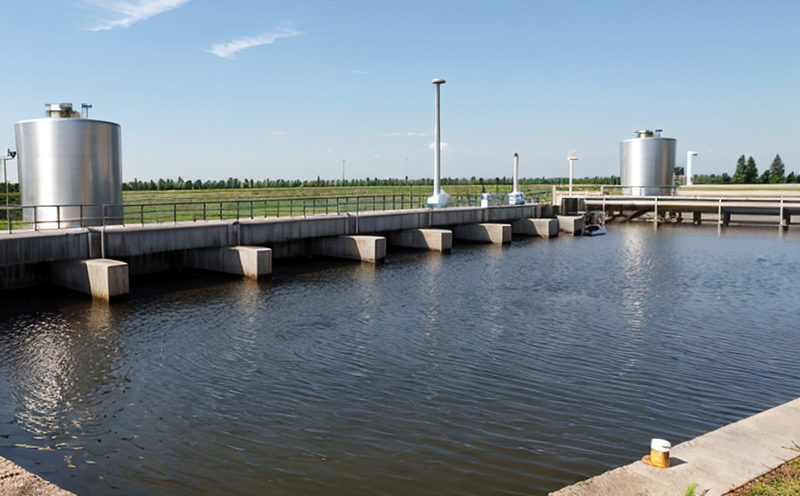ISO 13999 Cryptosporidium and Giardia Detection Testing
The ISO 13999 standard provides a comprehensive approach to detecting Cryptosporidium and Giardia, two of the most notorious waterborne pathogens. These organisms are particularly challenging due to their robust environmental resistance, ability to survive in diverse aquatic environments, and potential to cause widespread outbreaks. This testing protocol is critical for ensuring potable water safety, especially in regions with limited resources or infrastructure.
The standard outlines a method that combines filtration, concentration, and microscopic examination techniques to identify these parasites. A key aspect of this process involves the use of advanced filtration systems capable of capturing even the smallest particles—down to 1 μm—and subsequent concentration through various means such as centrifugation or evaporation. The specimens are then examined under a microscope for the presence of characteristic oocysts (for Cryptosporidium) and trophozoites (for Giardia).
The methodology is designed to be robust enough to handle a range of water samples, from surface waters to treated drinking water. It also emphasizes the importance of sample handling and processing under controlled conditions to minimize contamination risks. This includes the use of sterile equipment and adherence to strict protocols for specimen preservation.
Compliance with ISO 13999 is essential for entities involved in water treatment, public health agencies, and private water suppliers. Non-compliance can lead to severe consequences such as waterborne disease outbreaks, which have significant public health implications. Therefore, ensuring accurate detection of these pathogens is paramount.
The testing process typically involves several steps:
- Sampling: Collection of representative water samples from various points in the distribution system.
- Filtration: Use of microfiltration membranes to concentrate potential pathogens.
- Centrifugation: Centrifuging the concentrated sample to further isolate and concentrate the target organisms.
- Microscopic Examination: Visualization under a microscope for the presence of Cryptosporidium oocysts and Giardia trophozoites.
- Reporting: Documentation of findings in accordance with ISO 13999 standards to ensure reliability and reproducibility of results.
The accuracy and precision of this testing are crucial for regulatory compliance. Regulatory bodies such as the World Health Organization (WHO) and the U.S. Environmental Protection Agency (EPA) have set stringent guidelines regarding the presence of these pathogens in drinking water. The ISO 13999 protocol is designed to meet or exceed these standards, providing a reliable method for pathogen detection.
Quality assurance is an integral part of this testing process. Laboratories must adhere to strict quality control measures, including regular calibration of equipment and proficiency testing with reference samples. This ensures that the results are accurate and consistent across multiple tests. The use of standardized protocols also facilitates comparability between different laboratories, which is essential for public health surveillance.
In conclusion, ISO 13999 provides a robust framework for detecting Cryptosporidium and Giardia in water samples. This testing protocol is not only critical for ensuring drinking water safety but also plays a vital role in public health management. By adhering to this standard, laboratories can provide reliable, accurate, and reproducible results that meet regulatory requirements.
Scope and Methodology
The scope of the ISO 13999 Cryptosporidium and Giardia Detection Testing is extensive, covering various aspects of water sample preparation, pathogen identification, and reporting. This section will delve into the specific steps involved in this comprehensive testing process.
Firstly, sampling is a critical initial step that involves collecting representative water samples from different points within the distribution system. The choice of sampling locations is crucial as it ensures that the sample accurately reflects the overall quality of the water. Samples should be collected using sterile containers and handled under controlled conditions to minimize contamination risks.
Following collection, the samples undergo filtration through a microfiltration membrane with a pore size of 1 μm. This step is essential for concentrating potential pathogens, as it allows smaller particles to pass while retaining larger organisms such as Cryptosporidium and Giardia. The filtrate is then subjected to centrifugation, which further concentrates the pathogen population.
The concentrated sample is subsequently examined under a microscope using high-resolution imaging techniques. Microscopists trained in identifying these specific pathogens carefully inspect each slide for characteristic features of oocysts (for Cryptosporidium) and trophozoites (for Giardia). This visual examination is complemented by the use of specialized staining methods to enhance contrast, making it easier to identify these microorganisms.
The final step in this process involves reporting. Results are documented meticulously according to ISO 13999 guidelines, ensuring that all findings are transparent and reproducible. Reporting includes details such as the number of oocysts or trophozoites detected per liter of water, any potential contamination issues encountered during sampling, and recommendations for further action if necessary.
Quality assurance is an integral part of this testing process. Laboratories must adhere to strict quality control measures, including regular calibration of equipment and proficiency testing with reference samples. This ensures that the results are accurate and consistent across multiple tests. The use of standardized protocols also facilitates comparability between different laboratories, which is essential for public health surveillance.
Frequently Asked Questions
- Enhanced public health protection by detecting pathogens early.
- Compliance with international standards, ensuring reliability and consistency.
- Accurate identification of Cryptosporidium oocysts and Giardia trophozoites for effective water treatment.
- Potential reduction in the incidence of waterborne diseases, leading to cost savings on healthcare.





